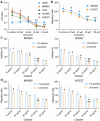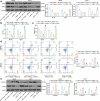Curcumol enhances cisplatin sensitivity of gastric cancer: involvement of microRNA-7 and the nuclear factor-kappa B/snail family transcriptional repressor 1 axis
- PMID: 35510522
- PMCID: PMC9275945
- DOI: 10.1080/21655979.2022.2070975
Curcumol enhances cisplatin sensitivity of gastric cancer: involvement of microRNA-7 and the nuclear factor-kappa B/snail family transcriptional repressor 1 axis
Abstract
Cisplatin is a primary chemotherapeutic drug for gastric cancer (GC) patients, but the drug resistance remains the leading cause of treatment failure and high mortality. Curcumol is a bioactive sesquiterpenoid that has reportedly been linked to cisplatin sensitivity in GC. This study focuses on the exact functions of curcumol in the cisplatin sensitivity of GC cells and the molecules of action. The curcumol treatment reduced the viability and migration and enhanced cisplatin sensitivity of GC cells in a dose-dependent manner. Microarray analysis suggested that microRNA-7 (miR-7) was the most upregulated miRNA in GC cells after curcumol treatment. The Kyoto Encyclopedia of Genes and Genomes pathway enrichment analysis showed that the curcumol-affected genes, including the target genes of miR-7, were enriched in the nuclear factor-kappa B (NF-κB) pathway, whose activity was suppressed after curcumol treatment. miR-7 was found to target and suppress RELA proto-oncogene (RELA, also known as p65), a NF-κB subunit. Downregulation of miR-7 blocked the sensitizing effects of curcumol on cells to cisplatin and led to increased expression of NF-κB p65 and snail family transcriptional repressor 1 (SNAIL). Further downregulation of RELA enhanced, whereas upregulation of SNAIL suppressed the sensitivity again. In summary, this study suggests that curcumol sensitizes GC cells to cisplatin via miR-7 and the suppression of the NF-κB/SNAIL axis. The findings may offer new thoughts that curcumol in combination with cisplatin might be a useful strategy for GC management.
Keywords: Curcumol; NF-κB/SNAIL; RELA; cisplatin; gastric cancer; miR-7.
Conflict of interest statement
No potential conflict of interest was reported by the author(s).
Figures








Similar articles
-
miR-155-5p inhibition promotes the transition of bone marrow mesenchymal stem cells to gastric cancer tissue derived MSC-like cells via NF-κB p65 activation.Oncotarget. 2016 Mar 29;7(13):16567-80. doi: 10.18632/oncotarget.7767. Oncotarget. 2016. PMID: 26934326 Free PMC article.
-
RKIP promotes cisplatin-induced gastric cancer cell death through NF-κB/Snail pathway.Tumour Biol. 2015 Mar;36(3):1445-53. doi: 10.1007/s13277-014-2496-6. Epub 2014 Dec 30. Tumour Biol. 2015. PMID: 25547433
-
MiR-192/NKRF axis confers lung cancer cell chemoresistance to cisplatin via the NF-κB pathway.Thorac Cancer. 2022 Feb;13(3):430-441. doi: 10.1111/1759-7714.14278. Epub 2021 Dec 24. Thorac Cancer. 2022. PMID: 34953057 Free PMC article.
-
Curcumol Suppresses Breast Cancer Cell Metastasis by Inhibiting MMP-9 Via JNK1/2 and Akt-Dependent NF-κB Signaling Pathways.Integr Cancer Ther. 2016 Jun;15(2):216-25. doi: 10.1177/1534735416642865. Epub 2016 Apr 28. Integr Cancer Ther. 2016. PMID: 27125675 Free PMC article.
-
Long Noncoding RNA Plasmacytoma Variant Translocation 1 Regulates Cisplatin Resistance via miR-3619-5p/TBL1XR1 Axis in Gastric Cancer.Cancer Biother Radiopharm. 2020 Dec;35(10):741-752. doi: 10.1089/cbr.2019.3342. Epub 2020 May 14. Cancer Biother Radiopharm. 2020. PMID: 32407172
Cited by
-
Curcumol Enhances the Sensitivity of Gastric Cancer to Cisplatin Resistance by Inducing Ferroptosis Through the P62/KEAP1/NRF2 Pathway.Integr Cancer Ther. 2024 Jan-Dec;23:15347354241294043. doi: 10.1177/15347354241294043. Integr Cancer Ther. 2024. PMID: 39511708 Free PMC article.
-
Curcumae Rhizoma: An anti-cancer traditional Chinese medicine.Chin Herb Med. 2025 Apr 24;17(3):428-447. doi: 10.1016/j.chmed.2025.04.006. eCollection 2025 Jul. Chin Herb Med. 2025. PMID: 40734908 Free PMC article. Review.
-
Reversal of chemotherapy resistance in gastric cancer with traditional Chinese medicine as sensitizer: potential mechanism of action.Front Oncol. 2025 Feb 20;15:1524182. doi: 10.3389/fonc.2025.1524182. eCollection 2025. Front Oncol. 2025. PMID: 40052129 Free PMC article. Review.
-
Curcumol: a review of its pharmacology, pharmacokinetics, drug delivery systems, structure-activity relationships, and potential applications.Inflammopharmacology. 2024 Jun;32(3):1659-1704. doi: 10.1007/s10787-024-01447-6. Epub 2024 Mar 23. Inflammopharmacology. 2024. PMID: 38520574 Review.
References
-
- Sung H, Ferlay J, Siegel RL, et al. Global cancer statistics 2020: GLOBOCAN estimates of incidence and mortality worldwide for 36 cancers in 185 countries. CA Cancer J Clin. 2021;71(3):209–249. - PubMed
MeSH terms
Substances
LinkOut - more resources
Full Text Sources
Medical
Research Materials
Miscellaneous
